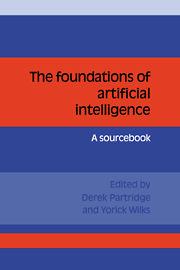Book contents
- Frontmatter
- Contents
- List of contributors
- Preface
- Acknowledgments
- 1 Introduction
- 2 The formal foundations of AI
- 3 Levels of theory
- 4 Programs and theories
- 5 The role of representations
- 6 The role of programs in AI
- 7 Rational reconstruction as an AI methodology
- 8 Is AI special in regard to its methodology?
- 9 Does connectionism provide a new paradigm for AI?
- 10 The role of correctness in AI
- 11 Limitations on current AI technology
- 12 Annotated bibliography on the foundations of AI
- Index of names
9 - Does connectionism provide a new paradigm for AI?
Published online by Cambridge University Press: 03 May 2010
- Frontmatter
- Contents
- List of contributors
- Preface
- Acknowledgments
- 1 Introduction
- 2 The formal foundations of AI
- 3 Levels of theory
- 4 Programs and theories
- 5 The role of representations
- 6 The role of programs in AI
- 7 Rational reconstruction as an AI methodology
- 8 Is AI special in regard to its methodology?
- 9 Does connectionism provide a new paradigm for AI?
- 10 The role of correctness in AI
- 11 Limitations on current AI technology
- 12 Annotated bibliography on the foundations of AI
- Index of names
Summary
Fodor restates his language of thought hypothesis, which presents a serious challenge to the view that the architecture of cognition is network-based. Fodor claims that, whatever the representation underlying thought at the level of semantic interpretation, it must have constituent structure, i.e. a structure such that belief in the truth of (A and B) necessarily involves belief in the truth of both of the constituents, A and B, separately. Such necessity is not, in general, supported by network architecture whereas it is in Turing machine-type representations.
The rest of the papers in this section respond (directly or indirectly) to this challenge to the significance of connectionism in AI. Is connectionism just implementation detail, an essentially Turing machine-type architecture implemented with an activity-passing network? Or are sub-symbolic networks inherently more powerful than the traditional symbolic-level processing representations that have dominated much of AI? Smolensky is firmly on the side of connectionism as a fundamentally new and powerful ‘sub-symbolic’ paradigm for AI. Wilks discusses and denies the central claims of both Fodor and Smolensky, arguing that, at the moment, benificent agnosticism is the best position on connectionism, awaiting further clarification of its claims and more empirical results.
Churchland supports the connectionist movement but his support is based on the similarities between connectionist principles and the architecture of the brain. He argues for the study of neuroanatomy as a source of system-building constraints in AI.
- Type
- Chapter
- Information
- The Foundations of Artificial IntelligenceA Sourcebook, pp. 287 - 288Publisher: Cambridge University PressPrint publication year: 1990



